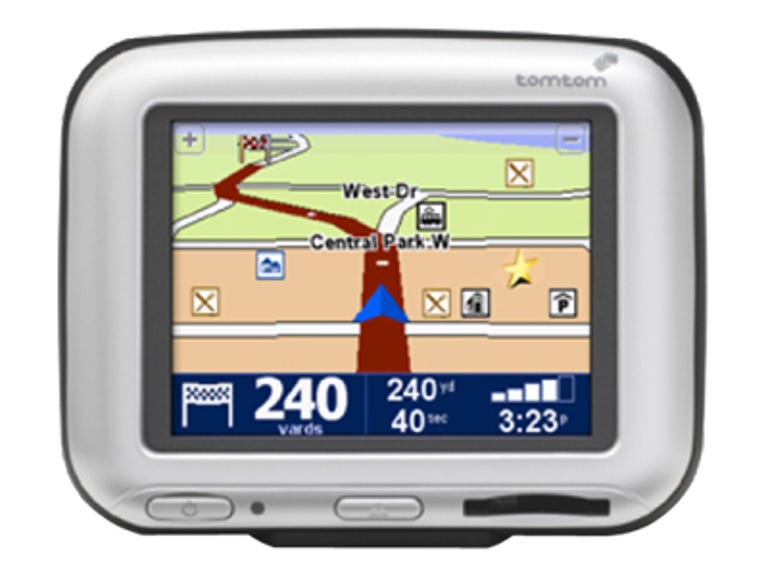Since the release of the Editors' Choice-winning TomTom GO, we've looked forward to the company's next-generation in-car GPS device. The TomTom GO 300 ($699.95) is one of two new products in the GO line (the other being the TomTom GO 700), and while the unit is physically identical to the original Tom Tom GO, it has a few new features, too. For instance, it now provides Bluetooth support for connecting to your Bluetooth-enabled cell phone or PDA and accessing real-time traffic and weather information via TomTom's Plus service. However, some of the new additions are less welcome, such as the antiglare coating, which actually makes the screen darker and harder to read in the sun. That said, the TomTom GO 300 still provides a simple plug-and-play GPS solution with accurate route guidance. The TomTom GO 300 has the same black case as its predecessor, with a silver bezel surrounding the 3.5-inch screen. If this color scheme doesn't suit you or your car's interior, you can buy a package of three interchangeable bezels (blue, gold, and black) for $20. The GO 300 keeps the compact dimensions of its predecessor (4.5 by 3.6 by 2.3 inches, 11 ounces), so it's easily transportable between cars. Plus, you get a sturdy suction-cup mounting arm that provides a wide range of adjustability.
TomTom pioneered the simple, user-friendly interface that many competing products, such as the Garmin StreetPilot c330, have adopted, and the GO 300 carries on the tradition. On the front you'll find a power button, a quick-release button for removing the unit from its mounting cradle, and an SD-card slot; a USB 2.0 port and a power jack are around back. Like the original, the GO 300 contains a single speaker with better-than-average tone response. Other than that, you enter all commands and requests via the responsive 3.5-inch touch screen. Speaking of which, TomTom added an antiglare coating to the 320x240 resolution, 4,096-color display, which makes the screen a bit too dark. Although it's easy to read under normal lighting conditions, ironically, it's difficult to read in direct sunlight.
The Good
The Bad
The Bottom Line
The TomTom GO 300 comes with everything you'll need to start navigating, including a cigarette-lighter adapter, an AC adapter, a USB cable, mounting hardware, a quick-start guide, and an installation CD with an online user guide. You even get a cloth to keep the touch screen clean. Our only complaint is that the GO 300 does not accept an optional remote control, although the more expensive TomTom GO 700 comes with one.
The GO 300 supports voice commands in more than 30 languages, and you can choose from more than 50 different types of voices to keep things interesting. New to this model is the speed-linked volume feature, which adjusts the voice volume level depending upon your vehicle's current traveling speed. Also new is a built-in Bluetooth connection for accessing TomTom's Plus services via your Bluetooth-enabled mobile phone. According to TomTom, service should work with any Bluetooth-enabled, GPRS-ready cell phone or PDA, but you can find a full list of compatible devices on the company's Web site. TomTom's Plus is a free service (until December 2005--the company hasn't decided what pricing structure to use thereafter) that provides real-time traffic and weather updates to help you avoid trouble areas and plan your trips according to the latest local weather. Through Plus, you can purchase and download additional voices, including a New York cab driver, a Mafia wise guy, and Monty Python's John Cleese. You can even have TomTom Plus locate and guide you to the nearest Wi-Fi hot spot.
TomTom's maps are colorful, and the street names are well defined. To keep the map screens uncluttered, you can opt to show only specific POI icons or turn them off altogether on the TomTom GO 300. The device calculates routes by fastest time or shortest distance, and you can instruct it to avoid toll roads and highways. The Advanced Planning function provides a good way to create and explore routes before you hit the road, and the Itinerary Planning feature is ideal for those long journeys that include multiple stops along the way. You can enter each stop as a destination from your address book or POI database, or you can enter them manually using the onscreen keyboard. The GO 300 will calculate the best routes between destinations or waypoints, giving you a good idea of how long it will take to reach the next stop and complete the entire trip. Itineraries can be edited and saved for future use--a handy tool if you're planning a return trip. Navigating through the user screens is fairly simple and straightforward.
The first time we initialized the TomTom GO 300, it took more than 10 minutes to acquire a 3D fix. Subsequent start-up times varied from 20 seconds to an excruciating 15 minutes, but long wait times were the exception rather than the rule. Once locked in, the unit performed flawlessly, pinpointing our position on the map and tracking our progress with great accuracy. Route calculations were among the fastest we've seen, as was the auto-rerouting feature. We rarely lost our satellite signals while driving through New York City, and when we did, it happened in areas that are notoriously tough on GPS receivers. Turn-by-turn voice guidance also worked quite well, and the alternative-route function helped us avoid an expressway traffic jam by rerouting us through a series of side streets and service roads. Pedestrians and hikers will like that the unit's internal lithium-ion battery lasted five hours before requiring a recharge.
